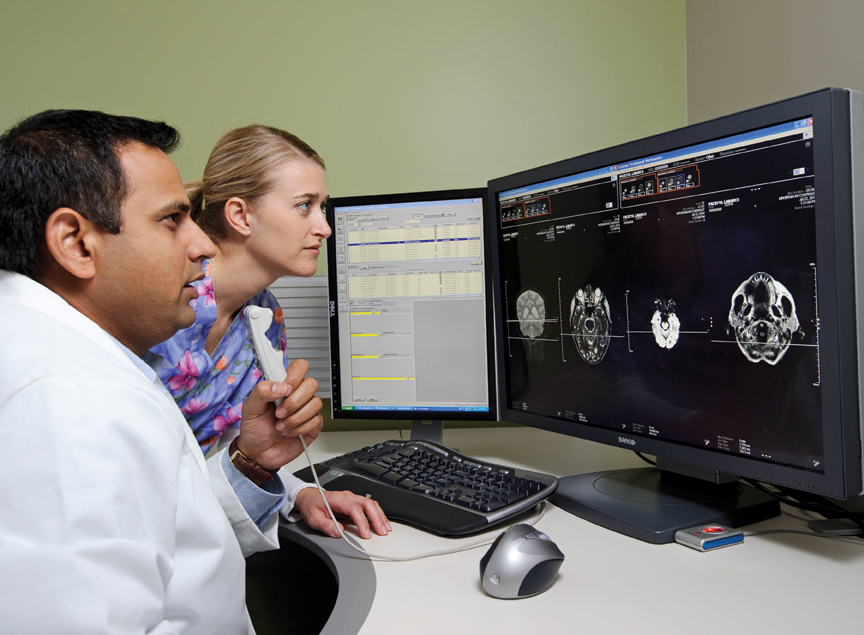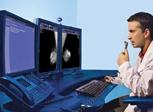
Horizon Medical Imaging Mammography Plus from McKesson offers a flexible solution to leverage investments already made in a radiology information system and picture archiving and communication system (RIS/PACS) to serve the full field digital mammography domain.
To know where you are going generally requires knowing where you’ve been, and this is as true for medical technology as for most anything else. Picture archiving and communication systems (PACS) are now ubiquitous, found in just about every radiology department in the United States. Those of you who read my blog (www.DoctorDalai.com) probably see me as “an average radiologist in an average practice in an average town in the South.” But there is one thing that sets our group apart from many others around the nation — the fact that we were early adopters of PACS.
Whether we were the twentieth or the fiftieth to take the leap, I cannot begin to say. But we were up there, which gives us a good deal of history to review.
Where We’ve Been
I’ve contacted many folks who were involved with PACS in the early days, and we relived some interesting times. I realized that there was a lot going on in the background of which I, a lowly new partner in the group at the time, was only dimly aware. There were many people whose involvement was critical.
First — and perhaps the most important factor in adopting a disruptive technology like PACS, even more critical than the funds to pay for it — is having a champion to lead the group and the hospital involved into the abyss. This person sets the tone for the move into the unknown, and success or failure often lies in his or her hands.
As a freshly-minted partner, I was nowhere near savvy enough to be our group’s PACS champion. Still, with the advantage of hindsight, when I take a look back critically today, there are things I would have done differently.
John, our PACS hero, was a well-educated body-imager, whose vision in things technical was second-to-none. Sadly, he often concentrated on what he thought would work for him, so his foresight sometimes resembled tunnel-vision more than anything. Even so, John had the inspiration to move us to soft-copy reading.
I’m not sure just how he convinced our group — and our hospital — to proceed. I suspect the fact that the hospital was bearing the financial burden of this sea-change probably had much to do with our acceptance. Most of the group was comfortable and even enthusiastic about the new paradigm. Even our senior partner, who finished residency before computed tomography (CT) was a reality, fully embraced the technology. But there were some...
Let me digress a moment, and amend my earlier statement about the importance of a champion to add that for something this new, it is equally important to have a guru, someone who can actually implement the technology. We were fortunate to have such a fellow. Mark initially was one of my nuclear medicine technology students, later one of my techs. When the PACS project hit the airwaves, Mark quickly became the genius behind the project. Without Mark, we might still be using film.
I also must mention Greg, the department administrator, who was instrumental in facilitating the process. He became immersed in IT and networking discussions and had to learn the language quickly. In the end, he became a staunch PACS advocate. So as with most endeavors, successful PACS adoption requires buy-in from several key people.
An Early Visit to the PACS Mecca
Well before wires were pulled and monitors placed, we visited one of the incubators for what is now PACS — the Radiology Dept. of the University of California at San Francisco. No doubt many other facility leaders made the same pilgrimage to see Dr. Bernie Huang, one of several “fathers” of the technology.
The UCSF department was really a big experiment in how PACS might develop. There were monitors from one vendor over here and controls or whatnot from another vendor over there. I was fascinated by a huge robotic magneto-optical drive juke-box.
Ironically, our patron who took us to see Huang was a fellow named Les, who owned the archival facility for our old film-jackets. Les was a visionary, seeing that this “electronic stuff” would eventually replace the tons of celluloid and silver that had made him rich. In our post-trip debriefing, I gave him the secret to making the whole thing work. The formula, I thought, was to put it all in one box. Having one vendor brand and sell everything was the key to ease of adoption and, frankly, I still think I was on target.
We finally brought our system online in 1993; it was small, with an early version of Agfa that formed a mini-PACS covering CT only. From there, we branched out to ultrasound, fluoroscopy and, eventually, computed radiography (CR) and nuclear medicine. Mammography, of course, did not go digital in our place for many more years. There were, of course, multiple incremental improvements.
Fast forward to 2003, when multi-slice CT necessitated a complete upgrade. John implemented a band-aid solution and then rather abruptly left us for a better place. (No, he’s not dead. He moved to Florida.) I documented much of this journey in a somewhat tongue-in-cheek fashion on my blog, www.DoctorDalai.com, which also has my “Laws of PACS.” Rather than rehash those posts here, I think it is more valuable to share a few other reflections.
For one, PACS was full of surprises, many of them financial. As Greg now puts it: “I will say, in hindsight, that we vastly underestimated the initial cost and the ongoing cost. I thought it would be like purchasing any other piece of imaging equipment. With a scanner, you buy it, install it and then in several years you look at replacing it. We had no idea of the ongoing cost, system upgrades, system expansions and dollars it would take to ‘complete’ the [PACS] install.
“In reality, I don’t think PACS is something that is ever finished,” he added. “When you reach one milestone, there is another area that needs change. For example, it has been nearly impossible for me to stay on top of what version of the software we are using. We had software upgrades, then more upgrades, then more, then conversion to Web-based, cacheless systems, etc. PACS is forever changing.”
The cost, to us end-users, is only one facet of what we didn’t know at the start. We also had no way of knowing which vendors would survive and which would fail; which interface would please the radiologists and which would get in our way, and so on. And we didn’t know the questions to ask on any of this.
The Human Side
Let me tie up these discordant historical threads speaking from the end-user (dare I say human) point-of-view. What we learned as early adopters of PACS has significant impact upon everyone who touches it.
I was lucky to enter this business with an engineering background. While this didn’t directly impact my PACS experience, I did learn to think like an engineer, and having my feet in both camps is invaluable. For example, an engineer (or IT type) may believe the more buttons on an interface, the better, as this allows for more precise control or options or whatever. But as a radiologist struggling with various graphic user interfaces (GUIs), I can tell you that a cleaner, streamlined interface is preferable for day-to-day reading in a production environment. The interface must not get in the way of the image. This is something many vendors have yet to grasp, too.
Personalities Make a Difference
When deploying a radical change in technology such as PACS, the abilities, nuances and even the feelings of the personnel involved have to be taken into consideration. Above, I alluded to the fact that “some” of our radiologists might not have quite been with the program. There was one superb imager, for example, who insisted that we all continue to read magnetic resonance (MR) images on film for several years into the PACS experience. One other fellow, not quite as savvy, continued to use an optical magnifying glass to enlarge images on the screen.
The second situation was just funny, but the first delayed our progress toward a filmless department, and for no good reason other than comfort and familiarity. Here, we see what can happen when someone refuses to adapt and adopt.
Conversely, John’s band-aid solution to multi-slice CT reading worked well for him, but for no one else. The lesson is simple: PACS has to work for everyone in the group, and certainly it cannot just be whatever IT and the vendors’ engineers think might work. Assuming something will work is a huge mistake.
Who Rules? Who Picks?
I often rail against “IT tyranny.” This is why I proposed that PACS be run by a consortium of radiology and IT, although sadly, we did not implement this partnership in our own department. Mark, our PACS boy-wonder, had to be moved from radiology to the auspices of IT. We (radiology) lost control of PACS and never really got it back. IT made most major decisions, investing a lot of time and money into one particular vendor’s products. Radiologists’ opinions (all right, my opinion) were rarely sought, especially when moving to PACS 2.0.
To negotiate this minefield, the only successful strategy I have found is to keep in mind just whom is targeted by PACS. To me, the radiologists and technologists are the proper end-users, while patients are the ultimate customers. We must be involved in the decision-making, but we have to drill down to what will work best for the majority of us. To this end, I’ve tried to expose as many of the end-users as possible to whatever change I want to make, although this doesn’t always work as well as I would like.
Journey Forward
Having almost 20 years of PACS experience hopefully has given my group the wisdom to proceed into the next 20 years of service with fewer pitfalls. Going forward, we will try our best to maintain a partnership with IT, which will probably manifest itself as me bugging them until they listen to my point of view.
Looking back, it’s amazing to think of the profound effects this technology has had on radiology. I doubt I’ll see another complete upheaval in the way we do business that is even minimally comparable to the effect PACS has had upon us — unless, perhaps, IBM’s Watson finishes his Radiology residency.
Samuel E. Friedman, M.D., is a nuclear radiologist and chief technology officer at Pitts Radiology, Columbia, S.C. He also is a well known blogger about everything to do with PACS, with an alter-ego as the Dalai Lama of PACS. On his blog at www.doctordalai.blogspot.com, Friedman describes himself as “just an average private practice radiologist in an average town in the Deep South.” Visit his blog for a rich archive of information and advice about PACS. He also serves on the ITN Advisory Board.



 December 01, 2025
December 01, 2025 









